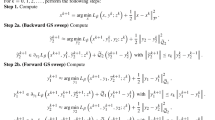Abstract
This paper presents a new multi-scale decomposition algorithm which enables the blind separation of convolutely mixed images. The proposed algorithm uses a wavelet-based transform, called Adaptive Quincunx Lifting Scheme (AQLS), coupled with a geometric demixing algorithm called Deds. The resulting deconvolution process is made up of three steps. In the first step, the convolutely mixed images are decomposed by AQLS. Then, Deds is applied to the more relevant component to unmix the transformed images. The unmixed images are, thereafter, reconstructed using the inverse of the AQLS transform. Experiments carried out on images from various origins show the superiority of the proposed method over many widely used blind deconvolution algorithms.






Similar content being viewed by others
References
Amari, S.I., Cichocki, A., Yang, H.H.: A new learning algorithm for blind source separation. Adv. Neural Inf. Process. Syst. 8, 757–763 (1996)
Comon, P.: Independent component analysis. New Concept Signal Process 36, 287–314 (1994)
Bell, A., Sejnowski, T.: An information-maximization approach to blind separation and blind deconvolution. Neural Comput. 7, 1129–1159 (1995)
Hyvarinen, A., Karhunen, J., Oja, E.: Independent Component Analysis. Wiley, Hoboken (2001)
Cardoso, J.F.: Infomax and maximum likelihood for blind source separation. IEEE Lect. Signal Process. 4(4), 112–114 (1997)
Hyvarinen, A., Oja, E.: A fast fixed-point algorithm for independent component analysis. Neural Comput. 9(7), 1483–1492 (1997)
Cardoso, J.-F., Souloumiac, A.: Blind beamforming for non-Gaussian signals. IEEE Proc. F 140(6), 362–370 (1993)
Chan, T.-H., Ma, W.-K., Chi, C.-Y., Wang, Y.: A convex analysis framework for blind separation of non-negative sources. IEEE Trans. Signal Process. 56, 5120–5134 (2008)
Naanaa, Wady, Nuzillard, Jean-Marc: A geometric approach to blind separation of nonnegative and dependent source signals. Signal Process. 92(11), 2775–2784 (2012)
Chan, T.-H., Chi, C.-Y., Huang, Y.-M., Ma, W.-K.: A convex analysis based minimum-volume enclosing simplex algorithm for hyperspectral unmixing. IEEE Trans. Signal Process. 57(11), 4418–4432 (2009)
Torkkola, K.: Blind separation of convolved sources based on information maximization. In Proceedings of IEEE Workshop on Neural Networks and Signal Processing (NNSP’96), Kyoto, Japan, pp. 423–432, (1996)
Lee, T. W., Girolami, M., Lambert, R.: Blind separation of delayed and convolved sources. In Advances in Neural Information Processing Systems, vol. 9, pp. 758–764. MIT Press, (1997)
Smaragdis, P.: Blind separation of convolved mixtures in frequency domain. Neurocomputing 22, 21–34 (1998)
Dapena, A., Bugallo, M.F., Castedo, L. : Separation of convolutive mixtures of temporally-white signals: a novel Frequency-Domain Approach. 794 A. Ciaramella, R.Tagliaferri, M. Funaro In Proceedings of 3rd International Workshop on Independent Component Analysis and Blind Source Separation, San Diego, California, pp. 179–184, (2001)
Ciaramella, A., Tagliaferri, R.: Separation of convolved mixtures in frequency domain ICA. Int. Math. Forum 1(16), 769–795 (2006)
Sawada, H., Kameoka, H., Araki, S., Ueda, N.: Efficient Algorithms For Multichannel Extensions of Itakura-Saito Nonnegative Matrix Factorization 978-1-4673-0046-9/12 ICASSP (2012)
Schobben, D.W.E., Sommen, P.C.W.: A frequency domain blind signal separation method based on de-correlation. IEEE Trans. Signal Process. 50, 1855–1865 (2002)
Araki, S., Mukai, R., Makino, S., Nishikawa, T., Saruwatari, H.: The fundamental limitation of frequency domain blind source separation for convolutive mixtures of speech. IEEE Trans. Speech Audio Process. 119(2), 109–116 (2003)
Zibulevsky, M., Pearlmutter, B.A., Bofill, P., Kisilev, P.: Blind source separation by sparse decomposition. In: Roberts, S.J., Everson, R.M. (eds.) Independent Component Analysis. Principles and Practice, Cambridge (2001)
Kim, C.W., Ansari, R. Cetin, A.E.: A class of linear-phase regular biorthogonal wavelets. In IEEE International Conference on Acoustics, Speech, and Signal Processing. ICASSP, vol. 4, pp. 673–676, (1992)
Sweldens, W.: The lifting scheme: a new philosophy in biorthogonal wavelet constructions. SPIE Wavelet Appl. Signal Image Process. III 2569, 68–79 (1995)
Cetin, A.E.: A multiresolution nonrectangular wavelet representation for two-dimensional signals. Signal Process. 32(3), 343–355 (1993)
Benazza-Benyahia, A., Pesquet, J.-C., Hattay, J., Masmoudi, H. :Blockbased adaptive vector lifting schemes for multichannel image coding. Eurasip Int. J. Image Video Process. (IJIVP) 2007(1), 10 (2007) article ID 13421
Ansari, R., Cetin, A. E., Lee, S. H.: Sub-band coding of images using nonrectangular filter banks, 32nd Annual Technical Symposium. In: Proceedings of SPIE 0974, Applications of Digital Image Processing XI, p. 315, (1988). doi:10.1117/12.948473
Kim, C.W., Ansari, R. : Subband decomposition procedure for quincunx sampling grids. In SPIE Conference on Visual Communication and Image Processing, (1991), pp. 112–123
Kisilev, P., Zibulevsky, M., Zeevi, Y.Y.: A multiscale framework for blind separation of linearly mixed signals. J. Mach. Learn. Res. 4, 1339–1363 (2003)
Virtanen, I.: Entropy correlation coefficient, a measure of statistical dependence for categorized data. Paper presented at the 15th European Meeting of Statisticians, Palermo, Italy (1982)
Hattay, J., Benazza-Benyahia, A., Pesquet, J.-C.: Adaptive lifting schemes using variable-size block segmentation. In Proceedings of the ACIVS Conference, Brussels, Belgium, August 31–September 3, (2004)
Donoho, D.: Denoising by soft thresholding. IEEE Trans. Inf. Theory 41(3), 613–627 (1995)
Motzkin, T., Raiffa, H., Thompson, G., Thrall, R.J.: The Double Description Method. Annals of Math Studies, vol. 8, pp. 51–73. Princeton University Press, Princeton (1953)
Cochran, D., Gish, H., Sinno, D.: A geometric approach to multiple-channel signal detection. IEEE Trans. Signal Process. 43(9), 2049–2057 (1995)
Author information
Authors and Affiliations
Corresponding author
Rights and permissions
About this article
Cite this article
Belaid, S., Hattay, J., Naanaa, W. et al. A new multi-scale framework for convolutive blind source separation. SIViP 10, 1203–1210 (2016). https://doi.org/10.1007/s11760-016-0877-6
Received:
Revised:
Accepted:
Published:
Issue Date:
DOI: https://doi.org/10.1007/s11760-016-0877-6




